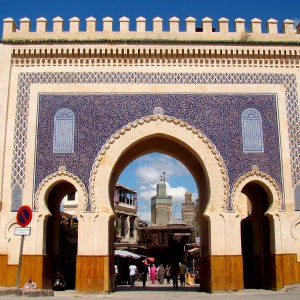Fes, also spelled Fez, is a city in Morocco that has a rich history dating back to the 9th century. It was founded by the Idrisid dynasty, which established the city as a center of Islamic learning and culture. During the Middle Ages, Fes was a major economic and intellectual hub, and it became one of the most important cities in the Muslim world. The city is also home to several historic landmarks and monuments, including the Bou Inania Madrasa and the Dar Batha Museum. In 1981, Fes was designated a UNESCO World Heritage Site due to its cultural and historical significance.
Fes is home to several historic monuments and landmarks, some of the most notable of which include:
- The Bou Inania Madrasa: built in the 14th century, this madrasa (Islamic school) is considered one of the most impressive examples of Marinid architecture in Morocco.
- The Dar Batha Museum: housed in a 19th-century palace, this museum features a collection of traditional Moroccan art and crafts, including ceramics, textiles, and jewelry.
- The Medersa Bou Anania: one of the most beautiful and best-preserved madrasas in Fes, built in the 14th century.
- The Bou Jeloud Gardens: these gardens were built in the early 20th century and feature a variety of plants and flowers, as well as a small palace.
- The Royal Palace of Fes: The palace was built in the 19th century and is still used by the Moroccan royal family, but parts of the palace are open to the public.
- The Fes el-Jdid: this neighborhood is home to the Jewish quarter and the Royal Palace, as well as the Mellah, which is the traditional Jewish quarter of Fes.
- The Kairouine Mosque: It is one of the oldest and most important mosques in the Muslim world, and it also contains one of the oldest universities in the world.
These are just a few examples of the many historic monuments and landmarks that can be found in Fes.
A cultural tour of Fes with Casablanca-tours.com would typically include visiting some of the city’s most historic and significant sites, such as:
- The Medina of Fes: The UNESCO World Heritage Site, it is the oldest of the four imperial cities of Morocco and is considered one of the most complete medieval cities in the Arab world. The tour would take you through the winding streets and alleys of the medina, where you can see traditional Moroccan architecture, colorful markets, and bustling souks (markets).
- The Bou Inania Madrasa: A 14th-century madrasa (Islamic school) that is considered one of the most impressive examples of Marinid architecture in Morocco.
- The Dar Batha Museum: This museum features a collection of traditional Moroccan art and crafts, including ceramics, textiles, and jewelry.
- The Medersa Bou Anania: a 14th century Madrasa, one of the most beautiful and best-preserved madrasas in Fes.
- The Bou Jeloud Gardens: these gardens were built in the early 20th century and feature a variety of plants and flowers, as well as a small palace.
- The Royal Palace of Fes: The palace was built in the 19th century and is still used by the Moroccan royal family, but parts of the palace are open to the public.
- The Fes el-Jdid: this neighborhood is home to the Jewish quarter and the Royal Palace, as well as the Mellah, which is the traditional Jewish quarter of Fes.
- The Kairouine Mosque: It is one of the oldest and most important mosques in the Muslim world, and it also contains one of the oldest universities in the world.
Additionally, a cultural tour of Fes would also include a visit to the traditional leather tanneries, where you can see the process of turning hides into leather and also to see the dye pits where the hides are colored.
A cultural tour of Fes would also include a visit to a traditional Moroccan hammam (bathhouse) where you can experience a traditional Moroccan bath, or a visit to a traditional Moroccan restaurant to try local delicacies.
